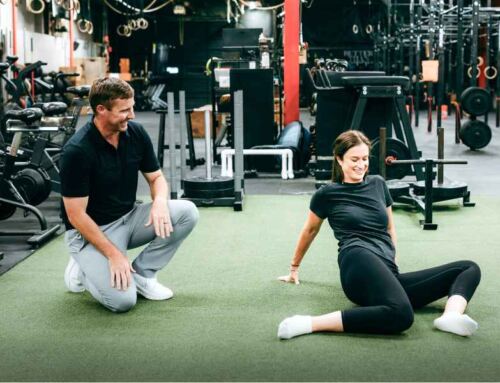Tips & Exercises for Overhead Athletes with Impingement
Shoulder impingement stands out as one of the predominant causes of shoulder pain, making up 44-65% of all reported shoulder complaints [1]. Frequent among the CrossFit community I collaborate with is the emergence of this type of shoulder pain, especially as members advance overhead barbell activities and incorporate dynamic gymnastic movements like kipping pull-ups & toes-to-bar. The discomfort often manifests at the front & top of the shoulder and presents as a pinching/sharp sensation when the arm move above 90 degrees of flexion. Although various factors can contribute to this pain, they commonly align with the overarching category known as shoulder impingement.
Physical therapy can be a very effective treatment method to not only treat, but prevent this from becoming a chronic issue. While many factors play a role in improving shoulder impingement, let’s start with some background and two of my favorite exercises you can implement today to start helping.

What’s Going On Behind the Scenes?
Shoulder impingement arises from a combination of weakened rotator cuff muscles and their impaired coordination, impacting the shoulder’s stability. The result is diminished control and stability of the humeral head within the glenohumeral joint.
The Rotator Cuff itself comprises four muscles: the Supraspinatus, Infraspinatus, Teres Minor, and Subscapularis. These muscles attach to the humerus at various spots. Each of these muscles plays a vital role in ensuring stability during various shoulder movements.
I’m a fan of all things outer space so stick with me for a moment. Envision a space shuttle navigating in outer space. Instead of relying on large, powerful engines for course corrections, it utilizes small yet effective thrusters. Similarly, the humeral head, like the shuttle, floats within the joint, and the rotator cuff muscles act as the thrusters, making subtle adjustments to prevent impingement during arm movements. Strengthening and improving the motor control of these muscles is an immediate way to support and enhance their corrective function. Here are my top 2 favorite exercises to start treating shoulder impingement!

Banded Rotator Cuff Strengthening
- Start with a light to moderate resistance band anchored to a solid object.
- Keeping your elbow tight to your body, hold the loose end of the band in your hand and gently rotate your arm out (like a windshield wiper) away from your body (External Rotation.)
- Perform, with good control, 2-3 sets of 8-10 repetitions.
- Repeat the exercise while rotating your arm towards your stomach for internal rotation.

Shoulder Drivers
- Start with your arms held at shoulder height, elbows locked out, and a light resistance loop around your wrists.
- Slowly begin to rotate your arms as if you’re holding a steering wheel in your hands to the left, then back slowly to the right.
- Perform 2-3 sets, rotating your arms 10 times each direction.

Conclusion
These exercises serve as an excellent starting point to restore shoulder health and enhance performance in overhead activities both at home and in the gym. For a personalized and progressive approach, working with a MovementX Physical Therapist is highly recommended. Their expertise ensures an individually tailored experience incorporating manual therapy techniques and exercises for continued improvement in overall function—whether it be at the gym or in various aspects of daily life.
Schedule your full examination with a MovementX Physical Therapist today!

References
- Creech JA, Silver S. Shoulder Impingement Syndrome. [Updated 2023 Apr 17]. In: StatPearls [Internet]. Treasure Island (FL): StatPearls Publishing; 2024 Jan-. Available from: https://www.ncbi.nlnih.gov/books/NBK554518/
- https://3dmusclelab.com/rotator-cuff-muscles-shoulder-pain/
About the Author
Dr. Romin Ghassemi is a physical therapist in Fuquay-Varina, North Carolina. He specializes in Orthopedic Conditions, Sports Injuries, and Neurological Conditions. Romin Ghassemi utilizes a variety of methods such as hands-on therapy, functional fitness, and mobilization to help you regain your strength, mobility, and vitality. Whether you’re an athlete recovering from an injury or just looking to enhance your overall well-being, he’s here to support you every step of the way!








